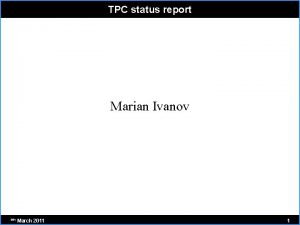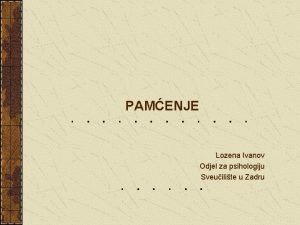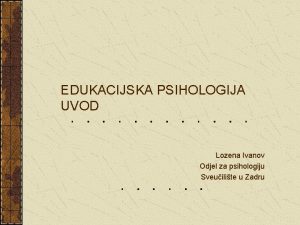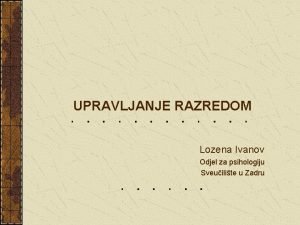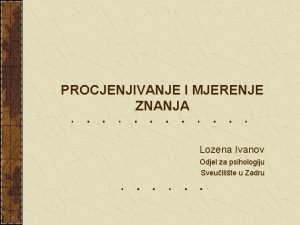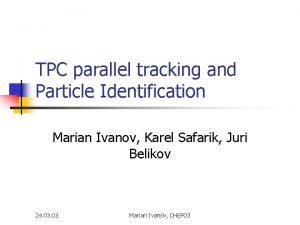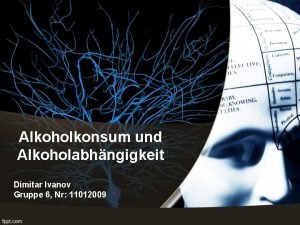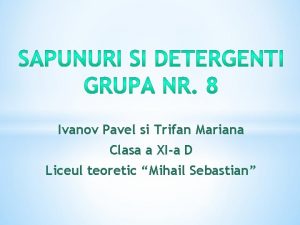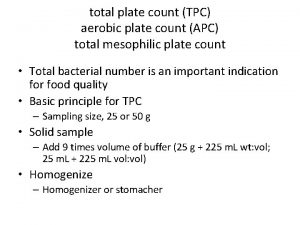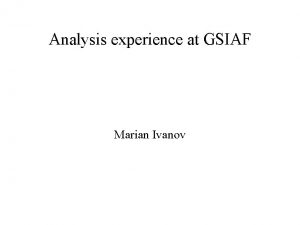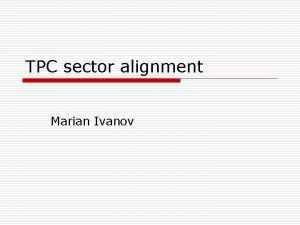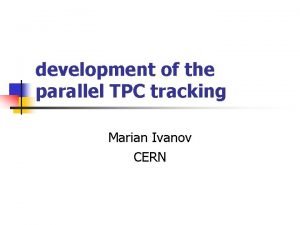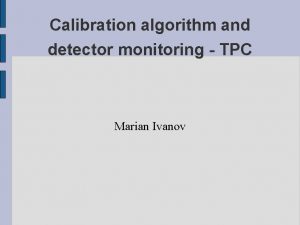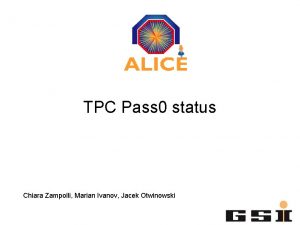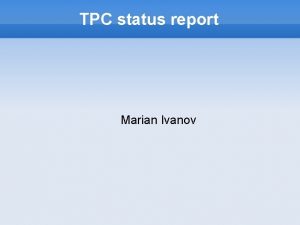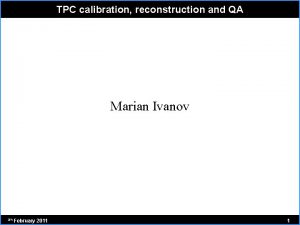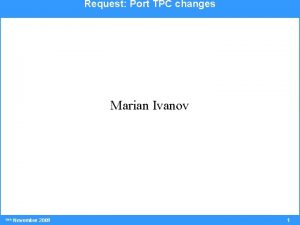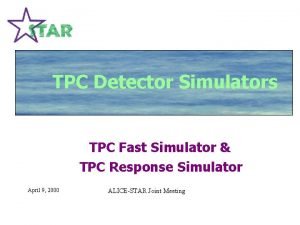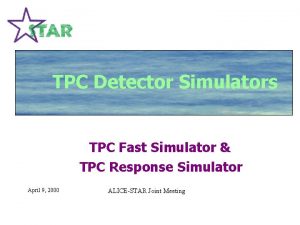Experience with analysis of TPC data Marian Ivanov

















- Slides: 17

Experience with analysis of TPC data Marian Ivanov

Outlook � TPC analysis Tasks � � Strategy Component model “Pseudo” online analysis of data TPC planning

TPC analysis tasks � � Reconstruction Calibration QA Physics analysis

Component model (0) � � Analysis tasks to be run in different environment Production – scope > 10^7 events � � Code development, fine tuning – scope ~ 10^5 events � � Alien - calibration and QA using tracks DAQ – calibration and QA using raw data HLT - calibration and QA using tracks Main goal – prepare stable code for Production mode Test the code before software releases Enable fast feedback for hardware experts Functionality of a component doesn't depend on the environment � � Clearly defined Input and Output e. g components developed for DAQ can run in HLT

Component model (1) � Interface: � Input � � Postprocessing � � Process(Ali. ESD *) Process(Ali. TPCseed*) Process(Ali. Raw. Reader*) Merge() Analyze() Export. QA() Output – Component itself, or QA folder

Component model (2) � Event loop outside of components – light wrappers on top of components � � Offline implementation � Ali. Analysis. Task->Ali. TPCAnalysis. XXX � DA (Calibration) maker schema to be adopted – merged with QA framework HLT implementation – Ali. HLTTPCComponent. XXX DAQ implementation – TPCXXXda. cxx Macros - TPCXXX. C

“Pseudo”-online analysis (0) � Input - Options � � � Output - Options � � � Alien storage element – Default (usually GSI: : SE) XRD cluster Data volume � � Files registered in Alien file catalog - Default Directly Castor Output size / Input size ~ 10^-3 Timing – appropriate “pseudo”-online analysis to be triggered by TPC software shifter after registration of the data in the file catalog

“Pseudo”-online analysis (1) Job list Alien. Toolkit t t. Make. Collection t. Make. Job. List Job description: Input Output Action Status Job agent Jobagent Job agent init: ●Check the environment ●Aliroot, Root, Alien, gc c ●Check the Output SE ●Make report ●if (problem) exit Loop on agent: ●until(Get. Next. Job()){ Check the availability of job input data ●if(!staged) {stage(); continue; } ●Lock the job ●Process job ●Transfer output data ● } � � � Job description – text file created by Alien. Toolkit (interface to TAlien, TAlien. Collection) Action – corresponds to the name of a root analysis macro (rec. C, KRCluster. Finder. C, . . . ) Job agents – can be run locally (first tests) or on a batch system

“Pseudo” online analysis (2) � � Presented schema (agent + pull mechanism) similar to Ali. En Main application: � � Tuning of the reconstruction algorithm – custom Ali. Root Verification of the Calibration algorithm � � In case of suspicious results of online calibration (DAQ or HLT) the reasons have to be understood Performance scaling – linearly with the amount of the job agents � � One lsf job – one job agent Actual jobs – in special process created by agent � Robust - In case of particular job crash – job agent non affected

“Pseudo” online analysis (3) � TPC February test � � 200 agents submitted to the CERN batch farm (GSI farm also tested) Feed-back time ~ hour(s) Modified reconstruction code committed to the svn � � 2 job types used � rec – 2 reconstruction passes � Kr. Cluster. Finder – 2 reconstruction passes To be used in the following central production on Alien Direct usage of the TPC algorithm on Alien � � Possible to use plain Root + TPC par + all needed Ali. Root libraries Not possible before, because par file couldn't be compiled

TPC planning for May, June

Plans for tests in May, June Production � DAQ calibration algorithm – Ready � � Calibration using tracks and Laser � � Not verified yet using real data – Will be not used for first iteration Gain calibration using Krypton � � � Full chain – DA=>FXS=>OCDB Calibration results and algorithm well tested Possible to use results of such calibration in production reconstruction Procedure tested – but, until now only C-side Planned to be used immediately after finishing Kr calibration on both sides Event type information needed for automatic reconstruction not yet implemented – Waiting for new RCU format

Plans for tests in May, June Production � General strategy – In production reconstruction, use only reliable, well tested calibration parameters � The influence to the physic performance summarized during Prague Physic week

Gain calibration Krypton calibration ● A. Matyja, MI, J. Otwinowski, (S. Gaertner) ●Time dependence of the gain using GOOFIE ● Reconstruction: Simple multiplication to be performed on the d. E/dx level ● Components: J. Castillo, M. Siska, MI ● FXS-SHUTTLE: Haavard ● Verify algorithms for calibration using tracks with the Krypton calibration (until now only verification using MC data) ● Components: MI, (S. Gaertner), A. Kalweit ● HLT component: J. Otwinowski, MI, M. Richter ● ● Calibration using tracks as a quality assurance ● QA extension of calibration components: A. Kalweit, MI

Ex. B effect Construct Ex. B correction table using measured magnetic field – Done ●Verify correction table using laser scan with different B fields (-0. 5. . -0. 2. . 0. 2 0. 5 T) ● ● To be done Adjust omega-tau factor (uncertainty ~20 %) ●Fit the mean angle between E and B vector (2 order correction) ●Estimate systematic effects ● ● Systematic effect to be added to the Covariance matrix of the track MI, M. Mager ●

Drift velocity ● Options: ● ● ● Goofie calibration + DCS values (T, P) - (ONLINE) ● Time dependence (Goofie) - to be corrected for the T and P at TPC ● Space dependence DCS values (T, P) – linear fit ● Relative precision 0. 05% (1 mm at vertex) Laser Central electrode - (ONLINE) ● Space and time dependence of drift velocity ● Relative precision ~ 0. 01 cm/250 cm ~ 0. 004 % ● Byproduct – unlinearities calibration – tuning of skirt voltage Calibration using tracks – (OFFLINE) ● Track crossing central electrode ● Reconstructed primary vertex position using the tracks from A and C side of the TPC ● Relative precision ~ 2 mm / sqrt(Nevents) ITS alignment – Kalman filter with w drift as parameter– under investigation MI, J. Wiechula, J. Castillo, M. Siska, M. Mager, ITS responsible(. . . )

Conclusion � � � Central first pass reconstruction will be performed with partially calibrated TPC Expected performance of the partially calibrated TPC sufficient for Physic papers The presented software schema for fast development and tests of analysis code enable us to shorten time between the first pass reconstruction and second pass, with a fully calibrated and understood TPC
